 2013 Winter Meeting Highlights
2013 Winter Meeting Highlights
Total Number of Attendees: 708
Workshops: 19
Sessions: 55
Crackerbarrels: 4
AAPT: Not Just for Teachers (A Student's View)
AAPT's 2013 Winter Meeting in New Orleans was organized around the theme, "And All That Jazz." The many attractions reflected the rich heritage of this major United States seaport located at the mouth of the Mississippi River. Twice a day the authentic steamboat, the Natchez, provided cruises on the river for the length of the city. Attendees enjoyed the world-renowned French Quarter, the historic Pontchartrain Hotel along with the city's many historic homes, the Magazine Street lined with boutique stores and antique shops, the Audubon Aquarium of the Americas, and the Audubon Nature Institute. Known for its distinctive Louisiana cuisine, "the Big Easy" is famous for its beignets, Italian Muffuletta sandwiches, Gulf oysters on the half shell, boiled crawfish, and those delicious  Creole dishes etouffe, jambalaya, and gumbo.
Creole dishes etouffe, jambalaya, and gumbo.
The AAPT Run/Walk, always a favorite activity, took attendees past many of the scenic highlights of New Orleans. The early morning event included historic Jackson Square, the French Quarter, and the river front. Everyone who participated in this event was a winner!
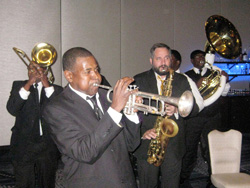
The rich musical heritage of New Orleans began during its pre-American and early American days. The unique blend of European instruments with African rhythms gave way to the birth of jazz and later to a brand of music known as rhythm and blues. Attendees had ample opportunity to hear live jazz performances at sessions during the conference during the Tuesday night live performance by one of the Preservation Hall's jazz bands.
Of course, technology had a high visibility throughout our meeting. Presentations ranged from "Best Practices in Educational Technology" to Online Tools and to Online Physics Courses. Some sessions reported on the use of tablets, smart phones, and the use of video games such as Angry Birds. AAPT staff streamed and videotaped the Symposium on Education Policy as well as the award and plenary talks. The meeting program was available for attendees to use on smart phones and tablets.
The Committee on Physics at Two-Year Colleges volunteered to have the Alternative Access Task Force record their session, "The Physics of Jazz." The session covered the physics of music using woodwinds, brass instruments, percussion, strings, and voice. A number of issues, including a hotel fire (not ours), relocation of the session, and failed technology made this a challenge. Thanks to the ipad of the Task Force Chair, partial YouTube videos of the presenters were recorded.
A special AIP exhibit, Exhibition on Historically Black Colleges and Universities, was on display throughout the meeting. Our physics education community is significantly underrepresented in number by ethnic minorities and women. Some paper sessions and one panel provided a forum to hear and discuss current and future efforts to 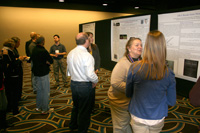 reduce this achievement gap.
reduce this achievement gap.
Poster sessions are always popular and this Winter Meeting provided opportunities for posters as part of poster sessions, part of regular sessions, and part of the SPS Undergraduate Research and Outreach Poster Reception.
We heard from three speakers during the annual Physics Education Public Policy Symposium on Tuesday as they report on issues concerned with K-12 physics and STEM Education. The speakers are Jim Gates, Univ. of Maryland and a member of PCAST, Ramon Lopez, Univ. of Texas, Arlington and co-Director of UTEACH Arlington, and Richard Steinberg, City College of New York and author of An Inquiry into Science Education: Where the Rubber Meets the Road.
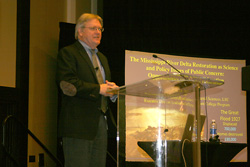 Dr. Mark Whittle, University of Virginia, addressed a "standing-room-only" audience on Monday night, with his talk entitled "The Universe’s First Million Years: Primordial Light and Sound." On Wednesday morning, Dr. Robert Twilley, LSU, spoke on “The Mississippi River Delta Restoration as Science and Policy Issues of Public Concern: Opportunities in Science Education.”
Dr. Mark Whittle, University of Virginia, addressed a "standing-room-only" audience on Monday night, with his talk entitled "The Universe’s First Million Years: Primordial Light and Sound." On Wednesday morning, Dr. Robert Twilley, LSU, spoke on “The Mississippi River Delta Restoration as Science and Policy Issues of Public Concern: Opportunities in Science Education.”
 Our AAPT award recipients delivered their special presentations during our Ceremonial Sessions. Edward "Joe" Redish, University of Maryland, recipient of the
Our AAPT award recipients delivered their special presentations during our Ceremonial Sessions. Edward "Joe" Redish, University of Maryland, recipient of the  Oersted Award, spoke on "The Implications of a Theoretical Framework for PER," and David Pines, University of California, Davis, recipient of the John David Jackson Award for Excellence in Graduate Physics Education talked about "What We Don’t Know, We Teach One Another."
Oersted Award, spoke on "The Implications of a Theoretical Framework for PER," and David Pines, University of California, Davis, recipient of the John David Jackson Award for Excellence in Graduate Physics Education talked about "What We Don’t Know, We Teach One Another."
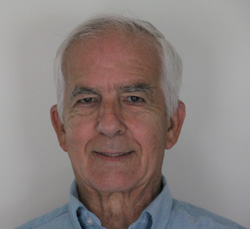

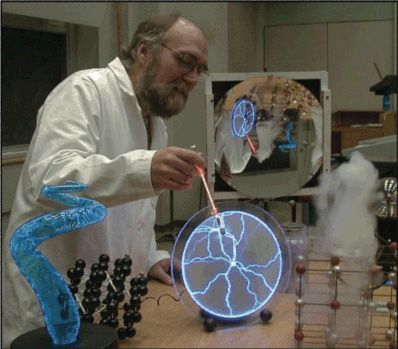
The Homer L. Dodge Citation for Distinguished Service to AAPT was presented to Stanley Micklavzinza, A. James (Jim) Mallmann, and Sarah (Sam) McKagan in recognition of their exceptional service to the AAPT Physics Education community.
 Continuing the tradition begun by Betty L. Preece, the Students Exploring Engineering and Science (SEES) Program provided a morning of hands-on learning for students from minority, low socio-economic schools. Learning was under the direction of the Society of Physics Students.
Continuing the tradition begun by Betty L. Preece, the Students Exploring Engineering and Science (SEES) Program provided a morning of hands-on learning for students from minority, low socio-economic schools. Learning was under the direction of the Society of Physics Students.

